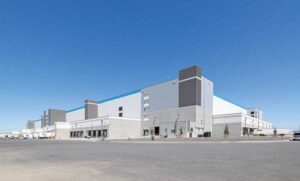IMPs versus Concrete
by marika_gabriel | 25 September 2023 7:00 am
 [1]
[1]When it comes to commercial construction, each project has its own unique set of factors that owners, architects, and specifiers take into consideration—everything from budget to location, size, purpose, environmental impact, performance, and aesthetics. Those same considerations apply to deciding on a wall system.
While traditional wall systems like tilt-up or insulated pre-cast concrete are widely used, an increasing number of architects are opting for insulated metal panels (IMPs). In a head-to-head comparison, IMPs outperform concrete on several fronts.
Embodied Carbon
The built environment is widely known for being a major contributor of greenhouse gas emissions. According to Architecture 2030, the built environment generates 40 percent of annual global CO2 emissions. Of those total emissions, building operations (Scope 1 emissions) are responsible for 27 percent annually, and building and infrastructure materials and construction (Scope 3 emissions) are responsible for 13 percent annually.
The most common materials used in the building industry are concrete, steel and timber. According to an MIT report, cement is one of the world’s most consumed resources. The process of manufacturing cement is extremely energy-intensive and complex, and results in contributing 8 percent of all CO2 emissions globally; that makes the cement industry the third largest emitter of CO2 in the world.
In comparison, IMPs are manufactured from metal skins (typically steel) and an insulating foam core. The steel in the panels can be made with up to 89 percent recycled content, sourced from electric arc furnace (EAF) mills, which also greatly reduces the embodied carbon required to produce the steel. The foam can be repurposed, both pre- and post-consumer.
A study conducted by architectural research and planning firm Kieran Timberlake looked at how different claddings in the design of an industrial building would impact embodied carbon levels. The study found that the models showed 28 percent less embodied carbon for a specific hybrid core IMP manufactured by one specific North American manufacturer when compared to traditional wall systems like insulated concrete and tilt-up concrete.
Cost
Cost is always a factor for a build; a study conducted by Currie & Brown, a global construction and asset management consultant, examined the installation costs of a specific hybrid core IMP wall system versus insulated precast concrete and tilt-up concrete wall systems in a typical warehouse or light manufacturing building of approximately 13,935.45 m2 (150,000 sf) gross floor area. A total of 18 cities across the United States and Canada were included in the study to provide a broad representation of regions.
The IMP wall system was, on average, 25 percent lower in costs in the U.S. and 27 percent lower in Canada, compared to insulated precast and tilt-up concrete walls. The potential cost savings ranged from an average of 18 to 32 percent depending on location, with the variation being largely driven by differences in local labor costs.
Design
IMPs have endless design possibilities, which means architects do not have to sacrifice style for durability, practicality, or performance. With a wide range of customizable design options, including colors, textures, and finishes, IMPs can be used to help companies highlight their brands through their buildings. They can also easily match any project’s aesthetic requirements, which allows them to be utilized in construction projects with a wide range of sizes and scope.
IMPs are at the forefront of innovation when it comes to building materials. Compared to tilt-up concrete wall systems, IMPs can be a lower carbon, cost-effective, and quality solution for construction projects of all types and sizes.
Brent Trenga is director of sustainability at Kingspan Insulated Panels North America.
- [Image]: https://www.metalconstructionnews.com/wp-content/uploads/2024/01/kingspan-distribution-facility.jpg
Source URL: https://www.metalconstructionnews.com/articles/features/imps-versus-concrete/